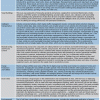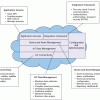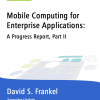Strategic advice to leverage new technologies
Technology is at the heart of nearly every enterprise, enabling new business models and strategies, and serving as the catalyst to industry convergence. Leveraging the right technology can improve business outcomes, providing intelligence and insights that help you make more informed and accurate decisions. From finding patterns in data through data science, to curating relevant insights with data analytics, to the predictive abilities and innumerable applications of AI, to solving challenging business problems with ML, NLP, and knowledge graphs, technology has brought decision-making to a more intelligent level. Keep pace with the technology trends, opportunities, applications, and real-world use cases that will move your organization closer to its transformation and business goals.
Recently Published
This Executive Report covers the benefits, considerations, and key steps involved in developing IoT-connected products and services, including connected device development, connectivity issues, sensors, supporting infrastructure, cloud-based IoT platforms, data storage and analysis requirements, and security and privacy.
Although very new, the predictive API (or PAPI) concept is important. With PAPIs, we see the direct availability of machine language analysis to create predictions in a manner that can easily be integrated with other APIs. This can be employed to create sophisticated mashups with predictive capability for use in decision making. It is linkage to decision making and the ability instantly to invoke machine language prediction from diverse realms that makes PAPI important. While relatively few examples exist today, the development of the API economy and the further progress of big data will ensure that many more PAPIs are developed in more diverse areas.
Here PPM Comes Again
This morning we happened to notice an announcement of a project portfolio management (PPM) conference for this summer. And Cutter's Summit in Boston features a Wednesday morning (6 May) roundtable on PPM.
We concluded Part III of our series "One Size Does Not Fit All" discussing horizontal flow in vertically siloed organizations (see Figure 1). In such organizations, both the flow of data and the flow of decisions across the silos might not be fast enough to satisfy the needs of the enterprise. The project teams may well be frustrated with the speed of the decisions that impedes their ability to deliver. An overly burdensome approval process leaves them powerless to improve.
IT Practices Challenge Continuous Delivery Adoption
This Executive Update centers on continuous delivery in contrast to all of DevOps, as it is much more well defined and a process upon which IT management practices have a direct and observable impact. We should, however, view continuous delivery as an element of DevOps adoption that is focused on the flow of work from development into production. Hence, these two terms are used interchangeably within this Update.
Trust-Growing Best Practices
Teams composed of business and technology professionals should identify problems and opportunities together. The era of top-down autocratic control is over. Teams with deep knowledge of technology and business models and processes should perform the tasks listed in this Advisor to generate credibility and trust.
This Executive Update completes a review of mobile offerings by the major enterprise applications players and makes some general observations about the barriers to adoption.

















